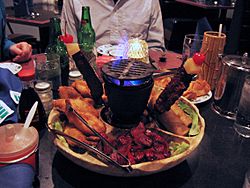Pu pu platter facts for kids
 |
|
| Course | Appetizer |
|---|---|
| Main ingredients | Meat and seafood |
| Pu pu platter | |||||||||||||
|---|---|---|---|---|---|---|---|---|---|---|---|---|---|
| Traditional Chinese | 寶寶盤 | ||||||||||||
| Simplified Chinese | 宝宝盘 | ||||||||||||
|
|||||||||||||
A pu pu platter is a special tray of different small meat and seafood snacks. These snacks are often found in American Chinese or Hawaiian restaurants. It's like a mix-and-match plate of appetizers.
A common pu pu platter in American Chinese restaurants might have egg rolls, spare ribs, chicken wings, and chicken fingers. You might also find beef teriyaki, fried wontons, fried shrimp, and crab rangoon. Sometimes, a tiny hibachi grill is included in the middle. This lets you warm up some of the food yourself.
The pu pu platter probably first came to restaurants in the United States mainland in 1934. It was introduced by a person named Donn Beach. Since then, it became popular at many Polynesian-themed restaurants. These places often have a fun, island-like style.
Contents
What Does "Pu Pu" Mean?
In the Hawaiian language, the word pū-pū means a small snack or appetizer. It can be a relish, a canapé, or an hors d'oeuvre. Originally, it meant "shellfish." But it also referred to small pieces of fish, chicken, or banana served with a drink called kava and beans.
Pu Pu Platters in Hawaii
Snacks in Hawaiian Restaurants
In Hawaii, pūpū have always been a common part of dining. Restaurants and bars often serve them. They are like finger foods that go well with drinks or as a light meal.
Heavy vs. Light Pūpū
Some places serve "heavy pupus." This means they have a buffet table with warm dishes. These might include chicken, tempura vegetables, shrimp, and poke. Poke is raw fish cut into cubes and seasoned. You might also find small skewers of teriyaki meat or chicken, and sushi.
Other places offer "light pupus." These usually only have cold foods. Examples are poke, sushi, and fresh vegetables. Sometimes, the pūpū are brought directly to your table.
Pūpū at Events
When people invite guests to parties or events in Hawaii, they often mention the pūpū. Invitations might say "light pupus" or "heavy pupus" will be served. This helps guests know if they should eat a full meal before coming or if the snacks will be enough.
Today, pūpū platters are very creative. Chefs arrange international foods to look beautiful and taste delicious. Modern pūpū platters can have traditional Hawaiian foods or exciting new combinations.
Pu Pu Platters on the Mainland
Tiki Bar Craze
During the time when tiki bars and restaurants were very popular, the pu pu platter became a big hit. In 1957, a Hawaiian-themed restaurant opened in New York City. Its pu pu platter was seen as part of a traditional luau feast.
What Was on the Platter?
A typical platter at that time might have included baked clams, rumaki (bacon-wrapped water chestnuts), and Shrimp Vela (fried shrimp with coconut). It also often had chicken wings, egg rolls, spare ribs, or Javanese sate (meat on skewers). These appetizers were served on a special spinning tray called a Lazy Susan. This tray was made of wood and had a small stove in the middle. The stove used charcoal to keep the food warm.
Today, some tiki bars still serve pu pu platters. They might include unique items like "Samoan deviled eggs" or "Chinese sausage and stick rice arancini." You might also find coconut shrimp and chilies stuffed with pork sausage.
See also
 In Spanish: Plato pupu para niños
In Spanish: Plato pupu para niños

